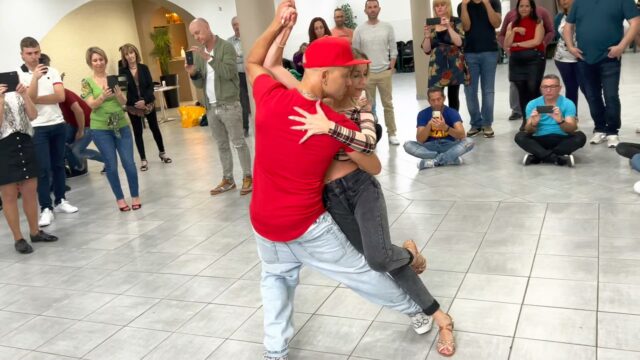Gliding across the dancefloor with grace and synergy between leader and follower is the epitome of social dancing. But leading a shy, insecure, or apprehensive dance partner can be tricky. As a leader, you set the tone for that dance partnership. Your follower’s experience often depends on your ability to make them feel comfortable, confident, and cared for on the dancefloor. Especially if you are a very experienced or famous dancer, your partner could feel shy at first. You can watch a great example of this situation and how Albir Rojas makes his follower Natalia feel confident and secure during their after-class performance:

So how can leaders thoughtfully guide self-conscious followers? The first step comes even before you step foot on the floor. Ask followers if they would like to dance rather than wordlessly pulling them onto the floor. This gives them a say in the matter rather than putting them on the spot. For new dancers just learning the ropes, ask what experience level they have with the style you’re dancing. This frames the invite as a collaborative effort to find compatibility rather than pressuring them to accept.
- Kizomba Meets Tango: Ben & Ana’s Masterful Workshop Demo
- Sara Lopez & Ivo Vieira: Captivating Kizomba to African Woman
- How Difficult is Kizomba to Learn?
Once you do have a shy or anxious partner on the floor, start the dance slowly and easily. Even if you’re itching to break into fancier moves, restrain yourself until your follower finds their footing. Quick intricate turns and tight spins early on may fluster them when they are still getting acclimated to connection and lead-follow dynamics. Start with basic steps and gentle solid leads that clearly telegraph your next moves to them. Resist the urge to plow full-steam onto the dancefloor just because the music is lively. Ease into the pace gradually instead.
As the dance progresses, pay attention to signals from your partner. Are they hesitant about following certain moves but become more confident later on? Does a particular rhythm or tempo make them tense up? Caring leaders learn to read these cues and adjust their dance accordingly rather than rigidly lead without regard for the follower’s experience. If you try a turn pattern and sense hesitation, switch gears to something more straightforward. If a song makes them anxious, suggest moving to a different part of the floor or sitting out that dance altogether rather than pushing through. Adjusting to followers shows consideration for their boundaries and comfort zones.
Leading different moves also requires distinct approaches with shy followers. On more complicated moves, lead gently and give them space to move rather than yanking them quickly across yourself. Subtle leads allow them to ease into position rather than feeling roughly manhandled into shapes. On turns, keep anchor points solid, predictable and balanced so they don’t feel out of control when spinning. Whether leading a turn, cross-body lead or dynamic dip, avoiding abrupt gestures prevents startling self-conscious followers.
Even missteps present opportunities to be a caring leader. If your partner makes frequent mistakes, don’t chide them or outwardly react. Gently re-lead moves without drawing attention to errors and remain patient as they learn. Should a major fumble happen like a near-collision or stepped-on toe, check if they are okay and give reassurance—don’t criticize their dancing. Laugh together, let any tensions diffuse, and continue enjoying the dance without dwelling on it. Handling mistakes calmly eases self-directed annoyance shy followers often already feel.
While engaged, attentive leading sets the stage for a positive experience, what you say also carries weight. Offer genuine compliments about moments where they followed well or took risks. Comments like “that cross-body lead felt smooth” or “you really committed to that outside turn” reinforce confidence. Conversely, avoid critiquing their dancing even light-heartedly as it draws attention to insecurities. The golden rule? Uplift more than critique.
Beyond in-the-moment social dance etiquette, broader efforts better support insecure dancers. Advocate for beginner-friendly nights and classes for shy newbies rather than exclusively advanced workshops. Personally invite wallflowers to join you for a dance rather than just hoping they overcome nerves. Foster an encouraging community that embraces dancers across skill levels so struggling beginners don’t feel unwelcome.
The hallmark of a thoughtful lead isn’t fancy footwork or flawless technique – it’s making followers shine through considerate connection. While beginners require patience and guidance from more experienced leaders, leaders can only grow from the reciprocal vulnerability, trust, and communication inherent to that partnership. Leading takes empathy and emotional intelligence. Yet the rewards of thoughtfully ushering anyone across the dancefloor make all the effort worthwhile.
If you enjoyed this article, feel free share it with your friends and let them know what you think about it. Also, consider checking out our most recent posts and stay in touch. Thank you!







